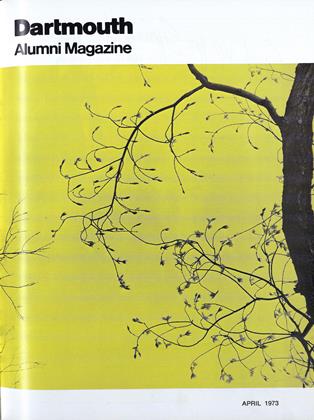By Carleton B. Chapman, M.D. (Vice President, Dean of the Dartmouth Medical School, and Professor of Medicine). Hanover: The University Press of New England, 1973. 106 pp. With 27 illustrations. $5.
It takes heart and skill to present a century and three quarters of history of exceptional interest in a little more than 100 pages, and that is what author Chapman has accomplished with this engagingly readable book. It is evident that his own assimilation of information about the nation's fourth oldest medical school is meticulous and far-reaching, yet this has not lent any heaviness to his subject. His book has the virtue of compactness for the reader in no way connected with medicine yet it is not a collation of highlights, for, despite the length of time it encompasses, it achieves the feeling of historical completeness.
Though not a medical and educational Johnny Appleseed, Nathan Smith apparently had the energy and fortitude for prolonged projection of a goal. After founding Dartmouth Medical School he went on to found similar institutions at Yale and Bowdoin. Both his energy and fortitude must have been in full flower when he was at Hanover because the medical school firmly took root, even though its every facility was initially contained in a single room. That the seedling must have had strong potential is apparent in the Dartmouth Medical School of today: now it is the educational component of the Dartmouth-Hitchcock Medical Complex, the largest medical facility in New England north of Boston.
Between single-room school and handsomely established institution there is much history indeed. Though Dr. Chapman himself probably would not put it this way, it can be said that he has told that history "like it is." There is romance in the education of medical students—in TV series. In actuality, it takes the rather vast amounts of perseverance and dedication that the best medical educators have, and this is brought out realistically and interestingly by the author. At one time, the school had to reduce itself from developer of full-fledged M.D. degree recipients to a two-year medical school whose students went on to other institutions to complete their medical educations. Further troubles evolved in a later day an were resolved with the school's present capability of granting M.D. degrees after three years of study. The author was the dean who brought this about and thus has been in a remarkably good position to bring the school's history literally up to date.
It may startle many people—even medically in people—to learn that the publication of this book gives the written history of the Dartmouth Medical School to the public for the first time. It can be recommended to everyone, and everyone who reads it will be glad he did.
A Dartmouth English major, trained as reporterand editor on The New York Times, aprofessional writer all his adult life, Mr. Thorne isnow a member of the Dartmouth Medical Schooladministrative staff.
 View Full Issue
View Full Issue
More From This Issue
-
 Feature
FeatureMedical Care via Television
April 1973 By BLISS KIRBY THORNE '38 -
 Feature
FeatureGuatemalan Cane Raiser
April 1973 By M.B.R. -
 Feature
FeatureArt Carpenter
April 1973 -
 Feature
FeatureHanover Has A Mardi Gras
April 1973 -
 Article
ArticleFaculty
April 1973 By ROBERT B. GRAHAM '40 -
 Article
ArticleThe Undergraduate Chair
April 1973 By DREW NEWMAN '74
BLISS KIRBY THORNE '38
-
 Article
ArticleMedical School
NOVEMBER 1971 By BLISS KIRBY THORNE '38 -
 Article
ArticleMedical School
DECEMBER 1971 By BLISS KIRBY THORNE '38 -
 Article
ArticleMedical School
JANUARY 1972 By BLISS KIRBY THORNE '38 -
 Article
ArticleMedical School
FEBRUARY 1972 By BLISS KIRBY THORNE '38 -
 Article
ArticleMedical School
MAY 1972 By BLISS KIRBY THORNE '38 -
 Article
ArticleMedical School
NOVEMBER 1972 By BLISS KIRBY THORNE '38
Books
-
 Books
BooksQUICK GUIDE TO WINE.
NOVEMBER 1966 By C.E.W. -
 Books
BooksBLACK ANGELS OF ATHOS
January 1935 By John Barker Stearns -
 Books
BooksEVERY DOG SHOULD HAVE A MAN.
December 1952 By John Hurd '21 -
 Books
BooksUNDERSTANDING FINANCIAL STATEMENTS AND CORPORATE ANNUAL REPORTS.
May 1962 By LEONARD E. MORRISSEY JR. '48T -
 Books
BooksTHE STORY OF BLINDNESS.
July 1956 By RALPH P. HOLBEN -
 Books
BooksTHE BATTLE AGAINST ISOLATION.
January 1945 By Robert K. Carr '29


